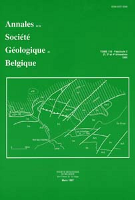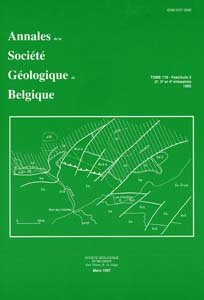- Accueil
- Volume 100 (1977)
- Volume complet
- Critères palynostratigraphiques conduisant à la reconnaissance d'un pli couché revinien dans le sondage de Grand-Halleux
Visualisation(s): 269 (2 ULiège)
Téléchargement(s): 473 (6 ULiège)
Critères palynostratigraphiques conduisant à la reconnaissance d'un pli couché revinien dans le sondage de Grand-Halleux

Abstract
The biostratigraphy based on palynology is given of the most important sections through the lower and middle Revinian of the Stavelot, Rocroi and Givonne massifs. Four assemblage-zones of interregional value are recognised. Assemblage-zone 4 (VANGUESTAINE, 1974) is subdivided into subzones 4a and 4b. The new biostratigraphic information confirms the earlier interpretation (VANGUESTAINE, 1968 and 1970) of black rocks recovered at the base of the Grand-Halleux borehole. They are of Revinian age and occur in a recumbent fold with a subhorizontal axial plane.
The palynological data combined with a lithological comparison of different sequences have shown that:
1.- there is a possible diachronism of lithofacies at the Rn1a-Rn1b boundary between the central part of the Stavelot massif and the overturned flank of the Revinian fold in the Grand-Halleux borehole ;
2.- there may be diachronism of the quartzitic rocks at the base of Rn2a in the normal and overturned flanks of the same borehole ;
3.- a condensed sequence or, possibly, even a stratigraphic gap exists at Revin (Rocroi massif) for the horizon corresponding to acritarch zone 3 and subzone 4a of the Stavelot massif ;
4.- the Rv2b horizon is diachronous between the Rocroi and Givonne massifs.
The stratigraphic distribution is given of several species selected on the basis of abundance, easily recognisable morphology and short ranges (Figs 3, 6, 8, 9). Some species which are either rare, of undifferentiated morphology or long ranging, are treated separately in Annexe I. Four plates illustrate both common and rare species of the different zonal assemblages. Annexe II deals with two new genera: Cristallinium and Timofeevia, as well as one new species : Timofeevia phosphoritica ; an additional two species, Hemisphaerium ? sp. A and Timofeevia sp. A, are newly described but left in open nomenclature. Four new specific combinations are proposed, viz. Cristallinium cambriense (SLAVIKOVA, 1968), Elektoriskos cerinus (VOLKOVA, 1968), Timofeevia lancarae (CRAMER et DIEZ, 1972) and Timofeevia pentagonalis (VANGUESTAINE, 1974).





